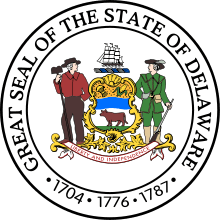91st Delaware General Assembly
The 91st Delaware General Assembly was a meeting of the legislative branch of the state government, consisting of the Delaware Senate and the Delaware House of Representatives. Elections were held the first Tuesday after November 1 and terms began in Dover on the first Tuesday in January. This date was January 1, 1901, which was two weeks before the beginning of the first administrative year of Governor John Hunn and Philip Cannon as Lieutenant Governor.
Governor John Hunn | |
|---|---|
 | |
| 91st General Assembly | |
| In office January 8, 1901 – January 6, 1903 | |
| Preceded by | 90th Assembly |
| Succeeded by | 92nd Assembly |
Currently the distribution of the Senate Assembly seats was made to seven senators for New Castle County and for five senators to each Kent and Sussex counties. Likewise the current distribution of the House Assembly seats was made to fifteen representatives for New Castle County and for ten representatives each to Kent and Sussex counties. The actual population changes of the county did not directly affect the number of senators or representatives at this time.
In the 91st Delaware General Assembly session both chambers had a Republican majority.
Leadership
|
|
Members
Senate
About half of the State Senators were elected every two years for four-year terms. Each was from a district in a specific county, with the number of districts determined by the state constitution, not the size of the population.
|
|
|
House of Representative
All the State Representatives were elected every two years for two-year terms. Similarly to the State Senators, each was from a district in a specific county, with the number of districts determined by the state constitution.
|
|
|
References
- Hoffecker, Carol E. (2004). Democracy in Delaware. Wilmington, Delaware: Cedar Tree Books. ISBN 1-892142-23-6.
- Martin, Roger A. (1995). Memoirs of the Senate. Newark, Delaware: Roger A. Martin.
Places with more information
- Delaware Historical Society; website; 505 North Market Street, Wilmington, Delaware 19801; (302) 655-7161
- University of Delaware; Library website; 181 South College Avenue, Newark, Delaware 19717; (302) 831-2965